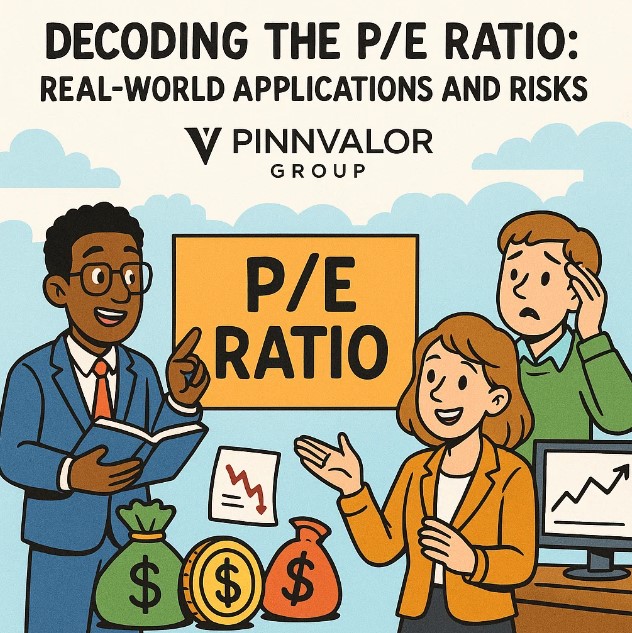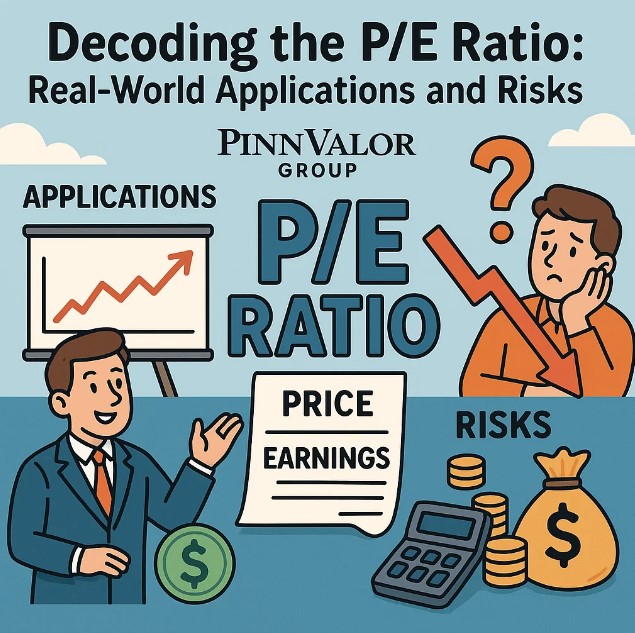
Decoding the P/E Ratio: Real-World Applications and Risks
The Price-to-Earnings (P/E) ratio is one of the most widely used metrics in the world of investing and financial analysis. Often referenced in stock research reports, media articles, and earnings calls, this deceptively simple figure carries a great deal of weight in decision-making. But behind its simplicity lies nuance, context, and risk. In this blog, we’ll unpack the P/E ratio, explore how it’s used in real-world investing, and highlight the common pitfalls investors should be wary of.
Is the P/E ratio telling you the truth about a stock’s value — or just hiding the risks?
Numbers tell a story, but the smartest investors know when to dig deeper and question the surface.
What Is the P/E Ratio?
The P/E ratio is a valuation metric that compares a company’s stock price to its earnings per share (EPS):
P/E Ratio = Market Price per Share / Earnings per Share (EPS)It answers a simple question: How much are investors willing to pay for ₹1 of a company's earnings? For example, a P/E of 20 implies investors are paying ₹20 for every ₹1 of earnings.
Types of P/E Ratios
- Trailing P/E: Based on actual earnings from the previous 12 months. Most commonly used.
- Forward P/E: Based on projected earnings for the upcoming 12 months. Useful for forecasting and evaluating growth expectations.
- Relative P/E: Compares a company’s P/E to a benchmark (industry average, market average, or peers) to assess if it’s over- or undervalued.
Real-World Applications of the P/E Ratio
1. Stock Valuation
Investors use the P/E ratio to assess whether a stock is overvalued, undervalued, or fairly priced:
- A high P/E may suggest a stock is overpriced or that investors expect high future growth.
- A low P/E may indicate undervaluation or potential trouble in the company’s fundamentals.
2. Comparative Analysis
The P/E ratio is particularly helpful when comparing similar companies within the same industry. For example, if two tech firms have similar business models but very different P/E ratios, it prompts a deeper look into growth rates, risks, and profitability.
3. Investment Style Alignment
- Growth investors often prefer high P/E stocks, expecting earnings to rise substantially in the future.
- Value investors seek low P/E stocks, believing the market has undervalued the company.
4. Market Sentiment Indicator
Shifts in a company’s P/E can reflect changes in investor confidence. A rapidly rising P/E could indicate optimism (or irrational exuberance), while a falling P/E may reflect fear or loss of faith.
Risks and Pitfalls of Relying on P/E Ratio
1. Ignores Growth Rates
A high P/E isn’t necessarily bad if a company is growing rapidly. Conversely, a low P/E doesn’t guarantee value if earnings are stagnant or declining. The PEG ratio (P/E divided by earnings growth rate) offers a more balanced view.
2. Earnings Can Be Manipulated
EPS is an accounting figure and can be affected by:
- One-time gains/losses
- Changes in accounting policies
- Share buybacks
This makes the “E” in P/E sometimes unreliable.
3. Not Useful for Non-Earning Companies
Companies with negative earnings (common in startups or cyclical downturns) have a negative or undefined P/E, rendering the metric useless.

4. Sector and Business Model Differences
Different industries have naturally different average P/E ranges:
- Tech companies tend to have higher P/E ratios.
- Utility companies often have lower P/E ratios due to stable but slower growth.
Comparing across sectors without adjusting for this leads to flawed conclusions.
5. Market Conditions Distortion
During market bubbles or downturns, P/E ratios may deviate significantly from historical norms due to herd mentality, fear, or speculation.
Best Practices for Using the P/E Ratio
- Always compare P/E to peers or historical norms, not in isolation.
- Use P/E in conjunction with other ratios: PEG, Price-to-Book, ROE, and Debt-to-Equity.
- Analyze the quality and sustainability of earnings behind the P/E.
- Be mindful of the business cycle: cyclical companies may look cheap (low P/E) at the peak of their cycle but are actually expensive.
Conclusion
The P/E ratio is a powerful yet imperfect tool. When used correctly, it provides valuable insights into how the market perceives a company's current performance and future potential. But like any tool, its effectiveness depends on the context and the hands that wield it. Smart investors look beyond the headline number, probing deeper into earnings quality, industry norms, and growth outlook before making decisions.
In the world of investing, numbers tell a story — but it's up to you to read between the lines.
